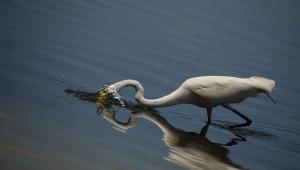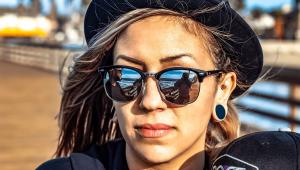Digital Help
Q&A For Digital Photography
Digital Help is designed to aid you in getting the most from your digital photography, printing, scanning, and image creation. Each month, David Brooks provides solutions to problems you might encounter with matters such as color calibration and management, digital printer and scanner settings, and working with digital photographic images with many different kinds of cameras and software. All questions sent to him will be answered with the most appropriate information he can access and provide. However, not all questions and answers will appear in this department. Readers can send questions to David Brooks addressed to Shutterbug magazine, through the Shutterbug website (www.shutterbug.com), directly via e-mail to: editorial@shutterbug.com or goofotografx@gmail.com or by US Mail to: David Brooks, PO Box 2830, Lompoc, CA 93438.
sRGB/Adobe RGB Differences
Q. I use Canon cameras, an Epson inkjet printer, and shoot mostly in the JPEG format. If a capture looks like it will need major Photoshopping I delete it. It’s a bad picture. All my digital cameras have sRGB as the default setting. The camera manuals imply that if you have to ask, you should stick with sRGB. Photographic publications further imply that if you read their work, you are ready for Adobe RGB. So, which color space should I select; Adobe RGB or sRGB?
Don Gerrish
via e-mail
 |
A. Both sRGB and Adobe RGB (1998) are color space profiles, but not typical because they are workspace profiles, which define the parameters/characteristics of the color space in which an image is captured and viewed.
The sRGB profile was established by a consortium of companies like Microsoft, Intel, and Hewlett-Packard to provide a standard that diminishes all images to look similar when displayed on a typical monitor, and was based on an average of CRT color monitors existing 15-20 years ago.
Both sRGB and Adobe RGB are rather dictatorial defining the basic parameters of what a color digital image contains. Both define the gamma as 2.2, and also the white color temperature as 6500K. The significant difference to photographers is the size of the color space (gamut) that is limited by both profiles. The sRGB profile, based on an average of early CRT computer monitors, has a very small sized gamut color space, while the Adobe RGB profile is much larger and encompasses the wide range of color the average contemporary digital camera captures with its sensor.
Not Everything Works The Same For Everyone
Q. After reading the e-mail in the December 2009 issue of Shutterbug from R.J. Sova, who was preparing to purchase the Nikon 5000 ED scanner, you are convincing me that I should send my negatives and slides out to a service such as ScanCafe to have them done. Actually your reply told me that scanning is not that easy and requires some experience
and knowledge.
First, I would suppose that one needs to thoroughly clean his negatives, and in the case of slides, clean and remount them before scanning, right? I would also guess that a scanning service would not perform a cleaning service. I have many negatives and slides dating back to Vietnam.
Would you recommend a scanning service over doing your own scanning?
Frank LeBlanc
via e-mail
A. I am not trying to convince anyone of anything, just sharing my experiences relative to a little understood situation with someone I don’t know, and I’m wary of a need for “quick and easy.”
Scanning is not quick and easy largely because every image is unique and every exposure a little different and all of the films add another large variable. So, to get just a good image does take a certain understanding, as does the learning of the process and the software tools to get it done.
It has been my experience that the film needs to be as clean as possible, but with some films (E-6 and C-41 process) there is an infrared dirt and scratch detection and cleaning system that has improved a lot, so very physical hand cleaning is not needed as much and can be damaging to the film image if done too roughly. To send images in to get scanned they should be brushed with a fine dust brush and blown off with compressed air, at least. Remounting slides is not essential, although I often put slides into better quality, more rigid plastic slide mounts.
I cannot make a personal decision for photographers. It all depends on the individual in terms of the time and energy available, the interest, plus the kind and variety of images involved. One thing anyone can do is make a selection of images that are seconds, or culls, but good exposures, and send some to scan services and see what they get back. That would help more than anything I might say to provide a basis for your decision.
Compression, Or Not?
Q. Are you saying that when I shoot in the Raw Uncompressed mode there is still compression of some sort? I assumed that uncompressed meant just that, no compression!
Gary Irons
via e-mail
A. Yes, the Raw files from all recent and contemporary D-SLR cameras are compressed with a no-loss proprietary compression program used by the camera companies. Each compression technology is different for each camera brand/model, so that is why they have to be opened with a software program that has the code needed to decompress the file. Just take a look at the actual file size of your D-SLR Raw file, then open the file and put the resulting image into Photoshop and you will see that the real size of the image which is posted in Photoshop is much larger than the Raw file size.
JPEG is a lossy file compression method that eliminates some of the image information to get the file size small. The Raw compression used by camera companies is a non-lossy method of compression that preserves all of the image information.
I don’t think any company today will say their Raw files are not compressed, but they are not compressed like JPEG that loses image information.
Samsung’s SyncMaster 245T LCD Display
Q. A friend also recommended the Samsung 245T, but I can’t seem to find any tech info about it. Does it require a stand-alone calibrator, and is the brightness adjustable to the specifications you recommend? The price does seem more attractive, considering I am upgrading my whole system. I have an OPTIX XR, but it is about the same vintage as my G5 and R800 printer.
David McDermott
via e-mail
A. First of all, here is the URL for a full Samsung 245T info page: www.samsung.com/us/consumer/office/monitors/
professional/LS24HUCEFV/XAA/index.idx?pagetype=prd_detail.
As for calibration and profiling, I am currently recommending the ColorEyes Display Pro. If you don’t currently have a sensor/colorimeter, with ColorEyes you can choose between at least two colorimeters. For more info, visit www.integrated-color.com.
Like all pro-graphics displays, the Samsung 245T has both a Contrast and Brightness control; both are essential for white luminance adjustment prior to calibration.
Home/Office LCD Displays For Digital?
Q. Thank you for everything that you do, especially your efforts in “prints too dark.” After reading your July 26th blog about the LGE L227WTG, I ordered one (after much searching) in hopes of helping with the prints too dark issue. Are you still pleased with this monitor and setting of 90.0 CD/m2 white luminance? Is this the same monitor that you referred to in your November 12th blog? I am currently using a 24” iMac 2.8GHz and was hoping to use the LGE with the iMac for the prints too dark issue.
Wayne Summers
via e-mail
A. I was hopeful that the LGE L227WTG would be an answer. But as you know it is a 2008 model and rapidly going out of stock. My own experience was that I could adjust it to 90.0
CD/m2 and get print matches in both color and density, but I found after working with it for a while that the color reproduction at 90.0 CD/m2 was not good enough. So, I moved it to my office and am now running it at 120.0 CD/m2, which is fine for non-color-managed office work.
Sorry to be disappointing, but apparently there just aren’t any low-cost current HD LCD display models that I can recommend. The best option today is the NEC SpectraView II P221W that is selling online for under $750 with software and colorimeter. Please see my report on this monitor in the February 2010 issue. It really works very well.
If you can still cancel your order maybe you should and reconsider your options and choices. Sorry, my blog is a current “what I am doing transcript,” and not everything I find that looks good turns out to be something I can say will work.
With the iMac you have, did you try ColorEyes Display Pro to adjust, calibrate, and profile it? Quite a few iMac users have reported it has worked for them. However, some report that getting the white luminance down to 90.0 CD/m2 was not a solution, but are working at 120.0 CD/m2 and getting good print matches. With iMacs, who knows?
I Only Recommend Products I Have Used
Q. I fully agree with you that making good prints using any scanning system takes a lot of knowledge and time since I have been doing it almost as long as you have. I still do not understand why you would never use a scanning service for your own photos, but you would recommend such a service to others. You also did not suggest the name of a good service, but I understand that you may not want to do so since this may affect your advertisers.
Thanks again for the information about the scanner systems you are currently using. I would love to have a report on the new Epson Perfection V600. I am using an older Epson scanner with fair results using both slides and negatives. I am also sorry that I have missed some of your earlier articles on scanning in Shutterbug, but I am a recent subscriber. Have you suggested Photoshop Elements, Photoshop CS4, or something else for picture editing?
Keep up the good articles in Shutterbug—I enjoy them.
Jim Gingrich
via e-mail
A. My film image library is a valuable resource to me and I live a long way from quality professional labs and service bureaus, plus my budget is such that I can only afford to do things myself rather than hire costly professional services.
I don’t make specific recommendations of services I have not personally evaluated. I just know they exist and some users have reported getting good service. That’s too dubious to make a specific recommendation, so all I can say is give it a try and find out if it works for you with some images that are not valuable.
The Epson Perfection V600 has so far reproduced some good scan image results, but I have more work to do with it.
Unless a photographer is doing very sophisticated stuff or is doing commercial photography, most will find the editing capabilities of Adobe’s Photoshop Elements are sufficient, with no significant difference in image quality in results. Personally, for a good part of my image acquisition from film to digital, I use LaserSoft’s SilverFast Ai scanner drivers and SilverFast HDR for image editing and processing, both for quality
and efficiency.
New—Datacolor’s Spyder3Express
Q. Spyder3Express costs only $89, and is being compared to Spyder2Express, so I am rather skeptical about the info I received from Integrated Color Corporation. Also, I think I’ll stick to my Spyder2PRO used with ColorEyes.
via e-mail
A. As I know it, there is no reason to be skeptical. There is only one Spyder3 colorimeter, and the device is the same as the Spyder3Elite I have. The main thing is, does the Spyder3Express have the internal support chip that allows connection to ColorEyes Display Pro? Integrated Color says it does. That is all that counts. I’ll buy one just to have a spare. It provides very good color sensitivity and an improvement over Spyder2.
By the way, if you check the Integrated Color website (www.integrated-color.com) you will see that they sell the software with a Spyder3 colorimeter.
- Log in or register to post comments


































